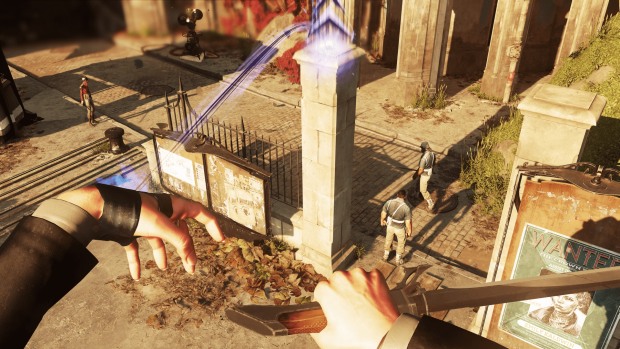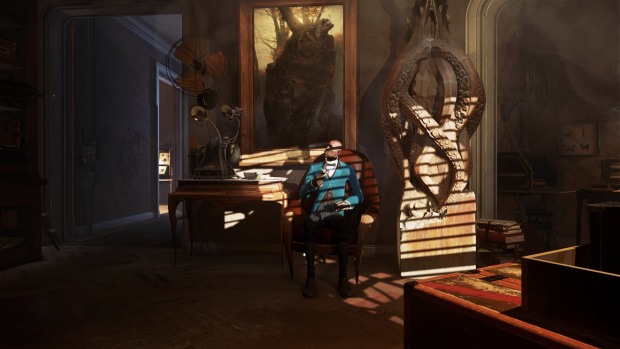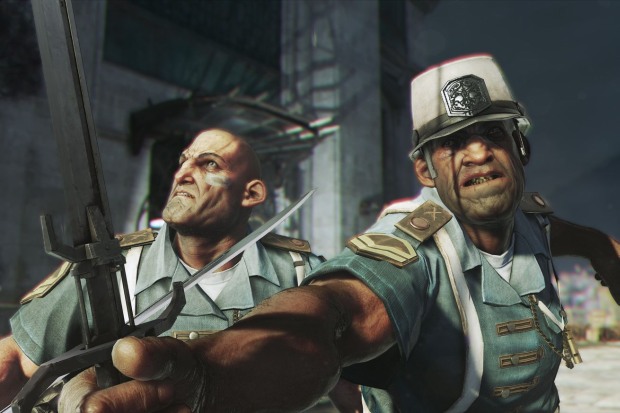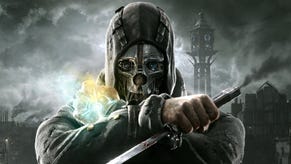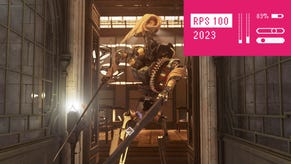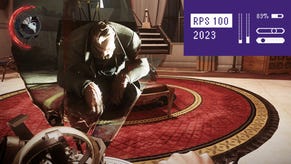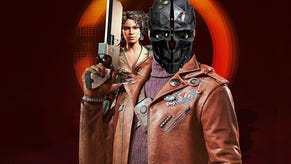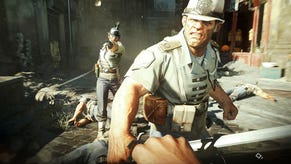The Beautiful Cruelty Of Dishonored 2
Reminiscent of the best of Portal and BioShock
Dishonored 2's fourth mission is supposedly about infiltrating the home of Kirin Jindosh, a sadistic inventor who must be bumped off or “neutralised” before he unleashes an army of automatons upon the world. But what you're really doing in the Clockwork Mansion is invading a brain. Having already seen excerpts from a developer playthrough, I had a sense that the building's rearrangeable mechanical layouts might reflect the character of its architect, much as Bioshock and Portal's labyrinths do GlaDOS and Andrew Ryan. I was unprepared, however, for how extravagantly Jindosh's neuroses infest the place, or for how cruel it feels to slip through the cracks in his amazing creation – past the velvet drapes, beneath the lacquered facades and into the whirring schematics of his subconsciousness.
If Dishonored 2 is a game you can “break” by combining gadgets and powers to create absurdly unlikely solutions to problems, the Clockwork Mansion is a space that is terrified of being broken. It's an opulent expression of a designer's paranoia. Stick to the mansion's surface layer, an elegant cluster of halls, corridors and laboratories that change shape at the tug of a lever, and Jindosh's manner is that of an indulgent tour guide, drawing your attention to this or that furnishing via a PA system, even as he summons robots to electrocute and dismember you. Abandon the main path, however - a simple matter of triggering a room transformation, then using Blink or the new Farreach spell to dash through a gap in the machinery - and Jindosh will lose his cool.
“It's cold and mirthless outside the walls,” he'll complain, unable to track your movements, as you pick your way through boiler rooms and enormous gearboxes, searching for one of many entrances to the lab at the mansion's heart. When you eventually step back into view, perhaps to steal a Bone Charm from a drawer or unplug the whale oil battery powering a forcefield, your adversary's relief is palpable. Jindosh's fear isn't, I think, that the player is out to murder him, but that there should be anything in his realm that escapes his attention. Framed notices to maintenance crews reveal a hyper-awareness to the slightest alteration. “Mind my sensitivities!” declares one. “No whistling while cleaning the windows.”
The mansion's protean architecture is oddly soothing to behold in motion - ceiling beams pull apart like wings unfolding, stairways collapse and vanish with well-oiled grace - and as you'd expect, working out which lever does what is very entertaining. There's a marvellous structure a couple of floors down from the entrance - a pint-sized, glass-roofed maze of motorised partitions linked to pressure panels where you'll find Anton Sokolov, a scientist from the first game who has been abducted to help Jindosh perfect his designs. On one level the mansion's shifting layout is immensely playful, the work of a team that is luxuriating in the capabilities of a new engine, but it also speaks to an intellect that can't stay put, that must brood ceaselessly over the world it has created for itself. “Sleep usually eludes me,” Jindosh confesses as you pull the lever that reassembles his bathroom into a bedroom. “My mind won't stop turning.”
This queasy interplay between environment and antagonist extends to the area's other NPCs. Some are less relevant to the level narrative - lumpy-faced guards whose sordid histories you can pick at using the Heart of Dunwall, which is still a wonderfully unnerving vehicle for backstory, and a pair of snotty aristos you might possess to reach the lower regions undetected. But there are also the towering Clockwork Soldiers, each voiced by its creator, which talk about themselves continually in a listless third-person.
These self-commentaries can be quite poignant. “The robot is uncertain,” one juggernaut offers as I contemplate it from the rafters, aiming a pistol loaded with explosive ammunition. It's as though you're at war with alienated fragments of your enemy's psyche, which makes the act of subverting a Clockwork Soldier's programming - either with a rewiring tool, or by blowing the creature's head off to rob it of the ability to distinguish friend from foe - a little like performing a lobotomy on the fly.
Dishonored 2's promise, for me, lies not just with the increased size and complexity of its environments or the sunny majesty of its equatorial setting, but with this greater capacity for cruelty. There's no shortage of simulations that let you toy with AI ecologies from the shadows, but few of them invest the act with much emotional import – they're flavourless bundles of variables that bounce together in the sanitised name of “fun”. In what I've played of Dishonored 2, by contrast, you deliberately assume the role of a predator, let loose on sandboxes that aren't just generic assemblages of systems but personalities in their own right, endowed with peculiar tics and trappings that arise from the malevolent yet sympathetic people they house.
You can, of course, vary the extent to which you abuse these scenarios – lower bodycounts equal less society-wide Chaos and (theoretically) fewer and more manageable opponents in subsequent chapters – but the art of invading a level like the Clockwork Mansion is fundamentally vicious. You needn't kill Jindosh to complete the mission, but you do have to break him, shattering the complex architectural mirror he has constructed for himself, in order to get to him. It's not clear whether all of the new game's levels will be as fraught with subtext, but for me this already represents a huge advance on the first Dishonored's exquisite but relatively literal-minded array of townhouses, factory floors and naval fortresses.
Another advance is that you actually feel like a personality this time, where Dishonored 1's Corvo was a mute, vengeful cipher thrown together to meet the changing requirements of a toolset that was still being perfected. Corvo's back, of course, but he has a voice now and more importantly, an ally to define himself against – Emily Kaldwin, his daughter and the recently usurped Empress of Dunwall. Emily isn't quite the Hyde to Corvo's Jekyll, but she's certainly a more ferocious and flamboyant choice of protagonist, designed for the player who really enjoys hurtling over the geometry and messing with AI behaviours.
The biggest initial distinction is that Emily's equivalent to Blink, Farreach, isn't a teleport-dash but a sort of mystic grappling line – it flings you forward in an arc, preserving your momentum when you arrive at your destination. This caught me off balance at first – I'd latch onto a street lantern above a fortified position, only to skim right past it and into hot water – but the sense of fluidity is irresistible. You might hit crouch as you land to slide, slicing the ankle tendons of a guard as you pass. By contrast, Corvo is more of a stop-start kind of aggressor, pausing time in order to sidle up behind people or carrying out controlled Blinks from cover to cover.
Emily's skillset is also about manipulating people where Corvo's powers lean on the element of disguise, or pitting an area's creatures against its human population. Her Mesmerise skill, for instance, conjures up a cosmic abomination to entrap beholders in a waking nightmare – not quite your average stun grenade, though it serves the same purpose. This isn't just variety for variety's sake: it's the difference between a woman born to rule and a blue-collar hero who had to claw his way out of the rat heap, putting on appearances in order to make his way in civilised society. I've never been that convinced by the game's Outsider deity, the pallid youth who is the source of all magic in Dishonored's universe, but I do like how deftly his gifts serve to illustrate Corvo and Emily as people.
Emily's most terrible power of all is Domino, which chains targets together within a certain range so that what happens to one happens to all. The ramifications are often spectacular – at one point I yanked three guards into the air simultaneously with Farreach, disembowelling one as she passed my vantage point while the others tumbled into an abyss. They can also be pleasantly unpredictable. Later, I was closing in on a sentry when he abruptly vanished in a cloud of sparks. I had, it transpired, forgotten that I'd linked the poor soul to another guard in the street behind, who'd managed to wander into a Wall of Light. It's a delightfully awful ability, both for the slapstick nature of the resulting combo effects, and for the sense that you're stripping away the world's class divisions. To murder an area's overlord by tethering his fate to that of a more easily accessed underling is to carry out a very unceremonious kind of social levelling.
Dishonored 2 is, then, shaping up to be Quite The Thing. As brilliantly grotty and multi-faceted as the new abilities are, it's the environment itself that has me hooked – these are warrens I'd happily plumb using nothing but my pitiful wits, the crouch button and a foldaway dagger, and you can, of course, play through the entire game that way if you prefer. The only question, again, is whether the game's other chapters will stand comparison with the psycho-geographical centrifuge that is the Clockwork Mansion – there's the one from the E3 demo that allows you to warp between two epochs in history, and I know of another that is set in a mining district, where the visibility is constantly changing as dust clouds billow across the layout. All of which sounds tremendous, but in need of a unifying figure to animate the level's props and give them meaning - a soul I can negotiate with and ultimately, lay to rest.
Dishonored 2 is due for release on November 11th, 2016.
Disclosure: erstwhile RPS writer and Alice's current flatmate Cara Ellison did some writing for Dishonored 2.


